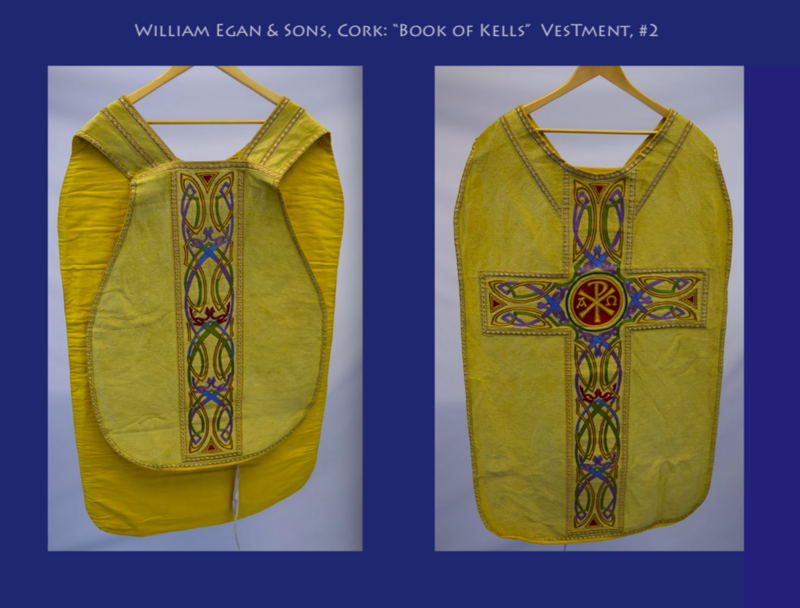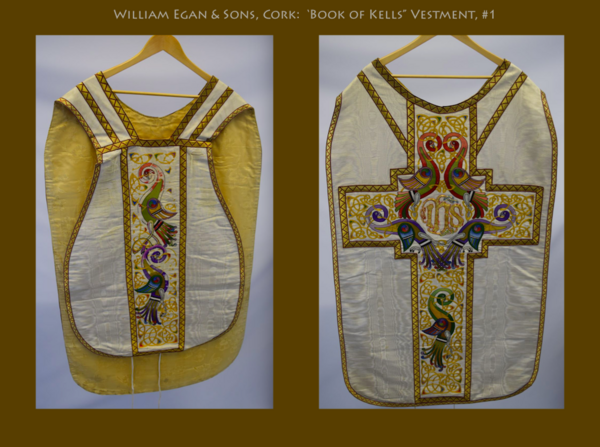Liturgical Vestments

William Egan & Sons

“Liturgical Vestments” (1920s) by Dr. Billy Shortall, Ph.D; Trinity College, Dublin
Chasubles made by William Egan & Sons, Cork, Ireland.
Embroidery on Irish Poplin. Makers label for Wm Egan & Sons Ltd, 31-32 Patrick Street, Cork with Déanta in Éirinn [Made in Ireland] trademark.
The O’Brien Collection
Elaborate neo-Celtic chasubles, outer vestments worn by a priest while celebrating mass, were made by William Egan & Sons in Cork during the 1920s. Made of ‘Irish poplin and Irish materials’, they are superb examples of Irish Arts and Crafts movement so-called ‘Celtic’ revivalist needlework.[i] These garments are representative of Irish revivalist movement principles of the late nineteenth and early twentieth century. This was marked by looking to ancient art forms and cultures for inspiration when seeking to create works that reflected a sense of Irishness, in literature, language, sport, and arts and crafts. This search for and (re)defining of Irish identity underpinned the political movement for Irish independence from Britain.
William Egan & Sons, were established in the 1820s in Cork, moved to their Patrick Street premises in the city in 1876, by which time they were most renowned for silversmithing. A late nineteenth century report describes, ‘The premises occupied by Egan & Sons comprise two magnificent adjoining shops - the one, No. 32, being devoted to high-class art jewelry, gold and silversmith's work, and watchmaking; the other being occupied in connection with the hardly less artistic business of ecclesiastical furnishing, vestment manufacture, and embroideries, appointments, and sacred utensils of every description.’[ii] Vestment production had become mechanized and produced as cheaply as possible in the preceding decades of industrialization. Costs were often upper-most in the minds of clergy and any Irish manufacturer had to compete with cheap imports.
In December 1920, during the War of Independence with the British, a reprisal attack by the Crown forces, namely the paramilitary ‘Black and Tans’, resulted in the ‘sacking’ of Cork and the burning of hundreds of premises, including Egan’s. Barry Egan, then proprietor, and grandson of the founder saved enough of the contents for the firm to start trading again from a temporary location in a matter of days. Notably, during the Irish Civil War in 1922, the firm marked their own silver with an old Cork emblem consisting of a castle and a ship for a short while, as sending work to the assay office in Dublin was fraught with danger.[iii] This 'Cork Republican silver' is now rare. A replacement Irish revivalist inspired building with a landmark clock, designed by Cork architects O’Flynn & O’Connor, was built in 1924, around same the time these vestments were produced. Like the vestments, the building facade was decorated with neo-Celtic designs. The building presented hope for the future of Cork and the Irish Free State and was an expression of a unique independent cultural identity.
Egan made all sorts of Church furnishings, ‘such as lace albs, surplices, oak altars, pulpits, brass candelabra, gongs, thuribles, sanctuary lamps, medals in gold and silver…’ but its production of hand crafted embroidered vestments only began in the later 1910s after Barry Egan had returned from a period of apprenticeship and study in silver-smithing and vestment making, in both Belgium and France.[iv] Egan’s was one of several Irish firms that sought to take advantage of a boom in Church building in Ireland across the country, which began in the 1830s post-catholic Emancipation, and continued into the twentieth century. Reflecting nationalistic political sentiments, there was a growing movement within the Church to substituting foreign decorative imports with Irish work. The poster child for an Irish designed and furnished church was the Revivalist Honan Chapel on the Cork University grounds consecrated in 1916. The building and decoration and fittings were conceived as a whole by the administrator of the bequest to build the chapel, Sir John O’Connell. The chapel is seen as a pinnacle in Irish Arts and Crafts, a movement that distinguished itself from its English and European counterparts through its appropriation of neo-Celtic ornament and Irish motifs such as the shamrock, round tower, harp, and Irish wolfhound. The Irish movement presented as distinctively Irish by positioning itself in a continuum from Irish medieval art. Ornament inspired by early Insular art was used in creative ways in a modern idiom. Items were handmade and used local or Irish materials as with these chasubles. William Egan & Sons received its earliest order for hand embroidered vestments from Monsignor Arthur Ryan of St Michael’s church, Tipperary for a ‘set of vestments in Celtic hand embroidery on cloth of gold’ in 1914.[v] The success of these vestments led to the firms most important Honan Chapel commission and other similar orders, such as the chasubles considered here. Skilled embroiderers and craft workers were recruited from the nearby Cork School of Art.
The Honan Chapel furnishings included Harry Clarke stained-glass windows, an Oswald Reeves enamel tabernacle, illuminations by Joseph Tierney, missal bindings by Eleanor Kelly, metalwork by W. A. Scott, altar frontals and other textiles by the Dun Emer Guild, as well as silver altar pieces and church vestments by William Egan & Sons. Although more elaborate, the vestments are similar in decoration and execution to those in the O’Brien collection. Honan’s O’Connell, in his 1917 introduction to the Irish Arts & Crafts Society exhibition which included two Chasubles by William Egan & Sons, demanded that revivalist decoration avoid a ‘slavish reversion to ancient forms’. The Studio review of the exhibition illustrated a ‘Chasuble of white poplin, embroidered, designed by John Lees, executed by Egan & Sons’ while noting it had ‘work of the best Irish craftsmen’.[vi]
Egan’s revivalist vestments of this time were mostly designed by John Lees, made under the supervision of Barry Egan, and embroidered by craftswomen from the Cork School of Art. It is not known whether these chasubles were made for a parish in Ireland or America, as Egan had an agent in the USA. The American church, many led by Irish priests and Bishops, was an important market for Irish church ware. Other craft studios also targeted trans-Atlantic business, including Harry Clarke Stained Glass Studios who supplied windows to multiple churches, Cuala Industries who supplied embroidered Stations of the Cross for a Jesuit Center in Pennsylvania, the Dun Emer Guild who exhibited revivalist inspired vestments at the Irish Art Exhibition in Chicago 1933, held in association with the Chicago World’s Fair, and Cluna Studios who exhibited Church banners at the same show.
The white chasuble presented here is decorated with a cross shaped orphrey panel on the back and a single vertical panel to the front. The orphreys are infilled with detailed elaborate interlace design in gold thread and stylized peacocks in multicolored threads. The borders and edges are in gold braid. Framed by four peacocks, IHS (a shortened form of the Greek word for Jesus) is the central element of the cross. The design is appropriated from early Insular religious iconography and in particular the Book of Kells. Peacocks are integral to the decoration in most of the major pages in the Book of Kells. Arising from the belief that its flesh does not putrefy, the peacock signified Christ’s incorruptibility.[vii] Chasubles are worn by priests for the celebration of the Eucharist (Christ’s presence in Mass) and the color is determined by the liturgical season or event, white is used on several feast days including Christmas and Easter.
The gold chasuble has a similar arrangement of braiding and orphreys but with looser interlace infilling in multicolored threads. The central cross element is a combined X and P – Chi-Rho (the first two letters of Christ's name in Greek) in gold thread on a purple ground with alpha and omega letters left and right. These are the first and last letters of the Greek alphabet and are an appellation of Jesus and of the Father in the Book of Revelation, the Beginning, and the End, to be interpreted that God is eternal. The associated stoles are decorated at each end with Book of Kells inspired Greek crosses with simple neo-Celtic ornament in multi-colored threads with identical braiding to the chasubles. Using religious and Irish revivalist iconography these vestments present a religious expression of Irish identity.
The Wm Egan & Sons label ‘Déanta in Éirinn’ [Made in Ireland] trademark stamp, replete with neo-Celtic design, infuses every element of the vestments; Irish materials; Irish revival; Irish identity; and Egan & Sons’ marketing politics.[viii] Nationalist politician and journalist, Arthur Griffith, writing in the republican newspaper, Sinn Féin, in 1909, said ‘The Irish Trade Mark distinguishes what is Irish from what is spurious.’[ix] Created by talented craftspeople, these vestments appropriate early Irish sources and apply them in a modern idiom, creating a new Irish artform for a new age.


Advertisement from 1932 for William Egan & Sons Ltd., and label on vestments
_____________________________
[i] Sir John R. O’Connell, The Honan Hostel Chapel Cork, Some Notes on the Building and the Ideals which Inspired It. (Cork: Guy &Co. Ltd., 1916). 58. O’Connell notes William Egan and Son’s use of Irish poplin and materials in making vestments.
[ii] Dublin, Cork, and South of Ireland: A Literary, Commercial, and Social Review. (London: Stratten & Stratten, 1892). 160.
[iii] Aodh O’Tuama, “Cork Republican Silver” in Irish Arts Review, no. 2 (1984): 52–53.
[iv] Elizabeth Wincott Heckett, “The Embroidered Cloths of Heaven, The Textiles” in Virginia Teehan and Elizabeth Wincott Heckett, eds. The Honan Chapel A Golden Vision. (Cork: CUP, 2004). 140.
[v] D.J. Coakley. Cork: Its Trade and Commerce. (Cork: Guy &Co. Ltd., 1919). 179.
[vi] P. Oswald Reeves, “Irish Arts and Crafts” in The Studio An Illustrated Magazine of Fine Art & Applied Art, Oct 15 1917, Vol 72 No 295. 15-22.
[vii] Bernard Meehan, The Book of Kells. (London: Thames & Hudson, 2012). 150.
[viii] Patrick Maume notes in The Dictionary of Irish Biography that the then Managing Director of the company Barry ‘Egan was co-opted to the first Sinn Féin-dominated Cork corporation at its first meeting in January 1920; in the same year he was elected president of Cork chamber of commerce.’
[ix] Sinn Féin newspaper (1906-1914) used the ‘Déanta in Éirinn’ trademark in its masthead from 1909.
MUSICAL REFLECTION (Guest Curator, Rose Flanagan)
The Musical Priest : Andy McGann & Paddy Reynolds, (fiddles); Paul Brady, (guitar)
https://open.spotify.com/track/0kn8dVNEhaH991hFYr8TB3
POETIC REFLECTION
INK
It’s made from what remains:
powder of oak galls, tincture
of iron, thin wine or vinegar--
a mixture mysterious as a hag’s charm
or potion aflame in a cauldron.
How could these monks know in the future,
twelve hundred years later, that their hooks
and angles carved in the skin of a small herd
of calves using pens cut with feathers
would make us stop in our tracks, full of wonder,
stunned by the mystery of the alphabet,
the fastness of the word.
Barbara Crooker
From her book, The Book of Kells (Cascade Books, 2018.)
Also of interest, From Darkness into Light, by Jane Simmons
https://www.amazon.com/darkness-into-light-poems-inspired/dp/1987609018